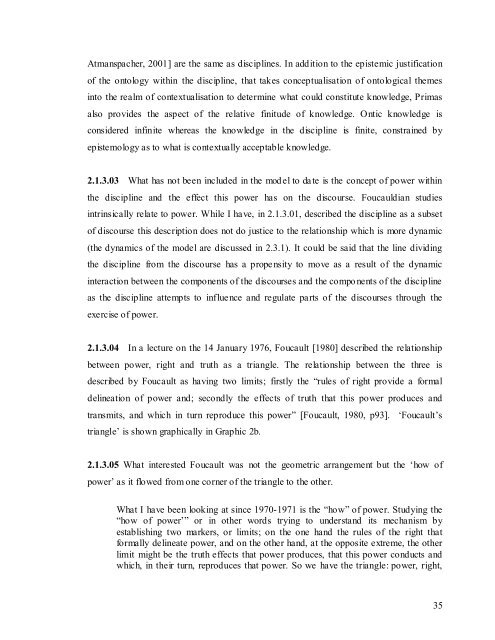Mapping the aliran of the academic discipline of entrepreneurship: A ...
Mapping the aliran of the academic discipline of entrepreneurship: A ...
Mapping the aliran of the academic discipline of entrepreneurship: A ...
Create successful ePaper yourself
Turn your PDF publications into a flip-book with our unique Google optimized e-Paper software.
Atmanspacher, 2001] are <strong>the</strong> same as <strong>discipline</strong>s. In addition to <strong>the</strong> epistemic justification<br />
<strong>of</strong> <strong>the</strong> ontology within <strong>the</strong> <strong>discipline</strong>, that takes conceptualisation <strong>of</strong> ontological <strong>the</strong>mes<br />
into <strong>the</strong> realm <strong>of</strong> contextualisation to determine what could constitute knowledge, Primas<br />
also provides <strong>the</strong> aspect <strong>of</strong> <strong>the</strong> relative finitude <strong>of</strong> knowledge. Ontic knowledge is<br />
considered infinite whereas <strong>the</strong> knowledge in <strong>the</strong> <strong>discipline</strong> is finite, constrained by<br />
epistemology as to what is contextually acceptable knowledge.<br />
2.1.3.03 What has not been included in <strong>the</strong> mod el to da te is <strong>the</strong> concept <strong>of</strong> power within<br />
<strong>the</strong> <strong>discipline</strong> and <strong>the</strong> effect this power has on <strong>the</strong> discourse. Foucauldian studies<br />
intrinsically relate to power. While I have, in 2.1.3.01, described <strong>the</strong> <strong>discipline</strong> as a subset<br />
<strong>of</strong> discourse this description does not do justice to <strong>the</strong> relationship which is more dynamic<br />
(<strong>the</strong> dynamics <strong>of</strong> <strong>the</strong> model are discussed in 2.3.1). It could be said that <strong>the</strong> line dividing<br />
<strong>the</strong> <strong>discipline</strong> from <strong>the</strong> discourse has a prope nsity to move as a result <strong>of</strong> <strong>the</strong> dynamic<br />
interaction between <strong>the</strong> components <strong>of</strong> <strong>the</strong> discourses and <strong>the</strong> compo nents <strong>of</strong> <strong>the</strong> <strong>discipline</strong><br />
as <strong>the</strong> <strong>discipline</strong> attempts to influence and regulate parts <strong>of</strong> <strong>the</strong> discourses through <strong>the</strong><br />
exercise <strong>of</strong> power.<br />
2.1.3.04 In a lecture on <strong>the</strong> 14 January 1976, Foucault [1980] described <strong>the</strong> relationship<br />
between power, right and truth as a triangle. The relationship between <strong>the</strong> three is<br />
described by Foucault as having two limits; firstly <strong>the</strong> “rules <strong>of</strong> right provide a formal<br />
delineation <strong>of</strong> power and; secondly <strong>the</strong> effects <strong>of</strong> truth that this power produces and<br />
transmits, and which in turn reproduce this power” [Foucault, 1980, p93]. ‘Foucault’s<br />
triangle’ is shown graphically in Graphic 2b.<br />
2.1.3.05 What interested Foucault was not <strong>the</strong> geometric arrangement but <strong>the</strong> ‘how <strong>of</strong><br />
power’ as it flowed from one corner <strong>of</strong> <strong>the</strong> triangle to <strong>the</strong> o<strong>the</strong>r.<br />
What I have been looking at since 1970-1971 is <strong>the</strong> “how” <strong>of</strong> power. Studying <strong>the</strong><br />
“how <strong>of</strong> power’” or in o<strong>the</strong>r words trying to understand its mechanism by<br />
establishing two markers, or limits; on <strong>the</strong> one hand <strong>the</strong> rules <strong>of</strong> <strong>the</strong> right that<br />
formally delineate power, and on <strong>the</strong> o<strong>the</strong>r hand, at <strong>the</strong> opposite extreme, <strong>the</strong> o<strong>the</strong>r<br />
limit might be <strong>the</strong> truth effects that power produces, that this power conducts and<br />
which, in <strong>the</strong>ir turn, reproduces that power. So we have <strong>the</strong> triangle: power, right,<br />
35

















